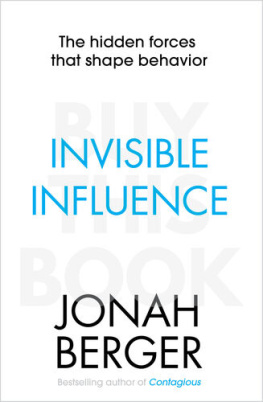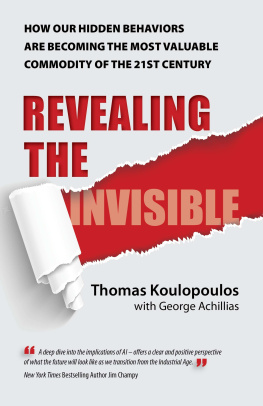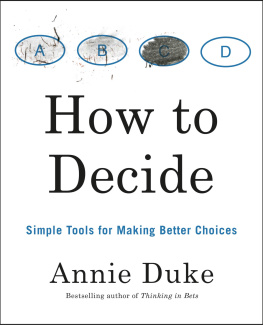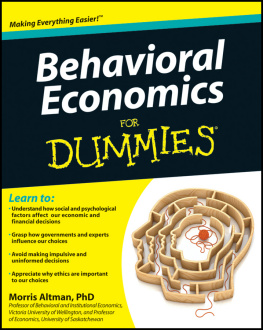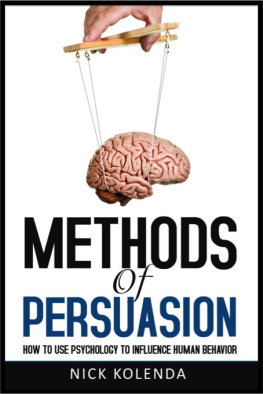Thank you for downloading this Simon & Schuster eBook.
Join our mailing list and get updates on new releases, deals, bonus content and other great books from Simon & Schuster.
C LICK H ERE T O S IGN U P
or visit us online to sign up at
eBookNews.SimonandSchuster.com
Contents
We make our own choicesright?... Why coming to class more makes students seem more attractive... How a couple of words change how we see people... When influence is invisible
Why we trust otherseven when they are wrong... When a Sprite is a Coke... How others provide information, and pressure... Why married people look alike... Ice cream and monkey brains... How to be a better negotiator... Explaining blockbusters... Why copycats get bigger tips... Avoiding groupthink
Why successful athletes have older siblings... The drive for distinction... How ordering with others can ruin your meal... Yogi Berra was right... Independence with a side of cranberry sauce... Why other peoples kids look the same but yours are completely unique... Why Sports Illustrated sells similarity while Vogue deals in difference
Why companies send celebrities free giftsfrom their competitors... How choices communicate who we are... When conservatives like generous welfare policies and liberals like stringent ones... Why frogs lie... Acting White and minority achievement... The $300,000 watch that doesnt tell time... Why expensive products dont use logos... Why Louis Vuitton should encourage counterfeiting... Explaining fashion cycles... Shifting signals to help health
Predicting the Color of the Year... Why hurricanes influence baby names... How similarity shapes success... What Chinese characters teach us about what will be popular next... Why familiarity leads to liking... Sex, chickens, and Calvin Coolidge... The Goldilocks Effect... Old and new at the same time... Engineering for optimal distinctiveness... Using a horse head to sell cars
What cockroaches can teach us about motivation... Why others make us faster runners but worse parallel parkers... Using peers to save energy... The importance of relative performance... Could losing be a good thing?... Why favorites are more likely to quit... Motivating employees, students, and others to work harder
Could where you live impact your health and well-being?... Choosing your influence
To Jordan and Zo
Introduction
Think about a choice you made recently. Any choice. Which breakfast cereal to buy, movie to see, or place to have lunch. Or even a more important decision: which person to date, political candidate to support, or career to pursue.
Why did you make that choice? Why did you pick the particular option you ended up choosing?
Seems like an easy question. While various idiosyncratic reasons may come to mind, in general, they all point in the same direction: you. Your personal tastes and preferences. Your likes and dislikes. Which potential mate you found funny or attractive. Whether the candidates policy stance matches your own. The notion that our choices are driven by our own personal thoughts and opinions seems so obvious that it is not even worth mentioning.
Except that its wrong.
Without our realizing it, others have a huge influence on almost every aspect of life.get in school, and careers they follow. It shapes whether people save for retirement, invest in the stock market, donate money, join a fraternity, save energy, or adopt new innovations. Social influence even affects whether people engage in criminal activity or are satisfied with their job. Ninety-nine-point-nine percent of all decisions are shaped by others. Its hard to find a decision or behavior that isnt affected by other people.
In fact, looking across all domains of our lives, there is only one place we dont seem to see social influence.
Ourselves.
I started studying the science of social influencethe way others affect our behaviorby biking around Palo Alto, California, looking for BMWs.
Palo Alto is one of the worlds most expensive places to live. Stock options and IPOs have fattened the pockets of many residents and have also pushed up everything from housing prices to private school tuition. Ferrari and Maserati have dealerships nearby; lunch at one of the high-end restaurants can run close to $200 per person.
Looking for BMWs was like hunting for Easter eggs. There was no surefire way to know where to find them, so I relied on a little intuition and a lot of luck. I slowly biked up and down different streets, scanning cars for the telltale shape and logo. Then, at each corner, I would stop and try to guess which direction had the best chance of success. Dentists office to the left? Dentists tend to drive nice cars, so why not do a quick loop of the parking lot. High-end grocery store to the right? Worth a shot.
Every time I found a BMW, I reached into my messenger bag, pulled out a piece of paper, and gingerly tucked it under one of the windshield wipers. These werent coupons for body shops or advertisements for auto detailing. We werent selling anything at all.
Instead, Princeton professor Emily Pronin and I were interested in how different factors influenced car buying. Which factors people thought influenced their own car purchase decision and how much those same factors played a role in someone elses BMW purchase.
In addition to standard factors like price, gas mileage, and reliability, the survey also asked about more social influences. Did their friends opinions affect their decision? What about whether the car was associated with cool or high-status people?
Each respondent answered the set of questions twice: once for themselves, and once for another person they knew who also drove a BMW. How much was that other persons BMW purchase influenced by things like price and gas mileage? Whether cool or high-status people drove something similar?
After biking around in circles most of the day, I had left surveys on more than a hundred BMWs. Each with a self-addressed envelope for people to mail their responses back.
And then, I waited.
The first day the mailman couldnt come fast enough. But when I opened the mailbox, all that was inside was disappointment. Just a bunch of random coupons and a furniture company catalog. No one had returned the survey.
The next day my optimism was tempered with caution. I sauntered by the mailbox and peeked inside. Still nothing. Now I was starting to get worried. Had people ignored the survey? Maybe the envelopes had blown away?
By the third day a feeling of dread accompanied the mail. If there were still no responses, Id have to go out and find new BMWs (or wed have to come up with a different approach). But finally, way in the back of the mailbox was the answer Id been waiting for. One of the small, white envelopes that I had placed on a car windshield a couple days before.
The next day there were a few more responses. And a bunch more the day after that. We were in business. We took the responses and compared peoples perceptions of themselves with their perceptions of others. What influenced their BMW purchase versus what influenced someone elses BMW purchase.
Many things were relatively similar. Not surprisingly, people thought factors like price and gas mileage mattered a lot, and they were equally important for both themselves and others. Price had a big impact on their own BMW purchase, and they thought it had a similarly large impact on whether another person had bought a BMW as well.
But when it came to assessing the impact of social influence, things changed. It wasnt that people didnt think social influence mattered. They did. They were keenly aware that car-buying decisions were affected by what friends thought and whether cool or high-status people drove the car. In fact, they readily acknowledged that social influence had a big impact on what cars people buy.
Next page



